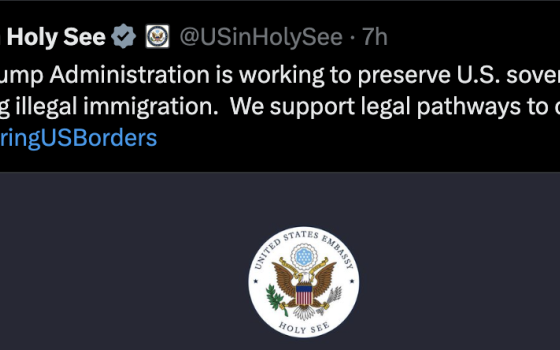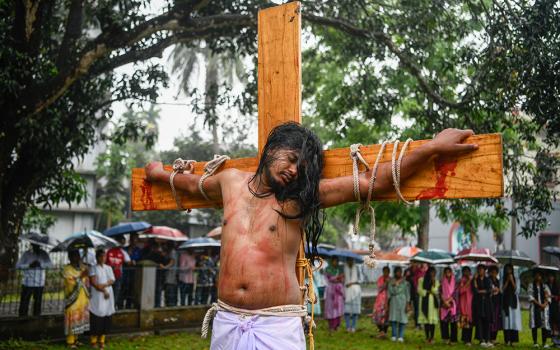
Commentary
I was fortunate enough to be in Haiti twice, once just three days after the earthquake and a second time during the third week post earthquake. My mind is filled with unforgettable experiences, but I want the children of Haiti to speak for themselves, so I will tell you their stories. Each one holds an important lesson for me and, quite possibly, for you, as well. Each child has a unique perception ... about life ... about Haiti’s political reality ... about faith ... about family ... about acceptance and most of all, about hope.
Pushon, 12-years-old, was one of the first children I met when I arrived on January 15th; three days after the earthquake had devastated Haiti. I was in Port-au-Prince, starting work in a makeshift hospital, set up in huge tents on the airport field. Pushon’s left leg was horribly crushed and held the odor of rotting flesh. Flies were gathering around the open wounds, bones were sticking out everywhere and the flesh was completely gone from the medial aspect of his lower leg. That leg looked like a picture from one of those anatomy books which shows muscles and vessels and bones, but it just wasn’t as neat as a picture. It was obvious we would have to amputate or he would die.
Pushon panicked when we told him. “No, no, no,” he begged, “I can wiggle my toes. See”, as he pointed to his toes. “You have a bad infection,” we explained, “You’re getting a fever. You will die soon if we do not cut off your leg.” He thought a full minute; a minute is a long time to wait for a 12 yr old to answer. He wet his lips before he spoke his mind. “My father needs me”, he said. “My mother is dead. My sisters are dead. My father needs me.”
Pushon knew what it meant to be an amputee in Haiti: unable to ride his bike, he would no longer be able to go to school or church. Children with deformities, moreover, were often shunned in school. Whether he did or didn’t go to school he would most likely never be able to get a job. In a country where that has an 80% unemployment rate, why would anyone hire a one-legged man when there were so many men with both legs?
At age 12 Pushon completely understood the social issues of his country.
He envisioned a future spent on the street begging, homeless, hungry, and dirty. There would be no Special Olympics for him, no school with handicapped access, no Rights of Disability Act passed by his Congress. He would need crutches for the rest of his life. He had never seen an artificial leg; he would never ride his bike again. Gone were his dreams of becoming a doctor.
And yet he chose to live, not for himself, but because his father needed him. Abandoning his personal aspirations, the boy had asked himself, “What will my father do if I die?” He had seen the pain in his father’s face after losing the rest of his family to the earthquake. Pushon chose to have the surgery, thereby giving the most that he could give --his leg-- so that his father could have hope! Pushon taught me a lesson of love.
On Jan. 17, five days after the earthquake struck, thirteen-year-old Barbara arrived with a dirty rag covering her face, revealing only her left eye, which had severe swelling and deformity. Most physicians and nurses have one thing that gets to them. For me it’s facial deformities. I simply hate them. I steeled myself as I removed the rag. Barbara’s good eye was looking right at me and I didn’t want her to see me cringe. Inside a voice was screaming, “Look at this deformity!” I could see flesh hanging and some bone showing. Half her nose was missing and deep beyond the bone there were visible signs of the inner workings of the sinuses. I heard air rush in and out, and there was a lot of pus and a horrible smell.
I remember she is thirteen, and the whole time she is talking and talking, once in a while taking a deep breath when something I did hurt her as I attempted to clear away the pus to get a better look. I can understand a little Creole and she is talking about how her faith in God has helped her. “I knew God would never abandon me, “she says. “When I saw my mother and grandmother dead I knew God would take care of me. I had been wandering the streets for days and then God helped me find you. From the moment the earth started shaking, I felt God inside of me. I knew God would take care of me. When I saw my mother dead I knew that I had to rely on God more.”
Barbara would need major reconstructive and plastic surgery. When I explained that we would need to get her to the USA, she cried with joy in English, “Oh thanks you Jesu ... I knew you helps me!”
This is a thirteen-year-old whose mother was dead; whose grandmother was dead, who had no house, no food and no face, and all she could do was thank Jesus! Barbara taught me to have the faith of a child in all situations.
By Jan. 18, six days post earthquake, the food we had been promised had not yet arrived and hunger was spreading. As a medical team we’d been advised to bring enough food and water for three days, but by this time I had exhausted the peanut butter and granola bars I had brought.
I was attending to James, 17, who had a concrete wall fall on him. It crushed his pelvis, sending a metal bar through his upper leg, through his privates, and into the other leg. Bedridden, James wasn’t going anywhere, so I asked him to guard my duffle bag that held all my expensive “doctor instruments,” worth thousands of dollars. He took the job very seriously and when he was sleeping, he would put his arm through the straps.
I had almost forgotten that I had a ziplock bag of nuts, raisins, and chocolate chips in the duffle bag. When I remembered and retrieved the food, James was starring right at me. I hadn’t eaten anything in 12 hours and I was hungry. This boy hadn’t eaten anything in days. Still, this was the only food I had left and I had to keep working 20-22 hours a day. No one knew when the promised food would arrive. James was watching me. I took out a handful of nuts and handed them to him. He immediately turned to the person in the next cot and gave half his nuts away; that child turned to the person next to her and gave half her nuts away, and so this went on, down about 6 cots, until the last person got just a few nuts.
Haiti is a country that knows hunger. In fact, it is one of the hungriest countries on earth. James taught me how to share.
On Jan. 20, eight days post earthquake, I treated four-year-old Sande, one of the lucky ones. Her mother was alive and Sande only had a fractured leg. Once the fracture was reduced and put into a cast she had tons of energy. When the shipments of crutches and walkers began to arrive, we found a small walker for her. There was lots of foot traffic and noise in the tents and Sande being only 4 years old was tiny, and adorable with her tiny walker and pink cast, We taught her how to say, “Hey you!” and as she walked around she would yell, “Hey you!” which translated into “I am coming through…get out of my way”. As the days went on, the tents became more crowded and noisier and no one could hear Sande’s “Hey you," so she would get the attention of those in her way by giving the road blocker a gentle punch in the back of the leg!
Sande taught me that when you are little you sometimes need to give a gentle punch to get what you need.
On Feb. 8, 22 days after the earthquake, Nahomie arrived. The 12-year-old had a crushed leg. She was evacuated to the northern region of Haiti where some of us were now tending the wounded. Her leg was amputated. The child was missing her mother who was miles away in Port au Prince
Nahomie was the patient who would hold the stump of her leg and cry the most. Every time she cried, I would give her a dose of morphine to settle her down and allow her to sleep. The passage of time didn’t slow her crying. I thought, It’s two weeks past surgery. She must be dealing with phantom pain.” Then one day as she was crying I put my hands around her face and she reached for me. I sat on her cot and she put her head on my lap, wrapped her arms around me, held me tight, the crying stopped, I held her and she went to sleep. It was then that I got it ... she needed human touch. Her mother was far away and her leg had been cut off. She didn’t need morphine; she needed someone to sit with her and hold her. From then on, I did a lot of holding.
Nahomie taught me to forget the drugs ... and remember the person!!
On Feb. 17, 36 days post earthquake, a U.S. military helicopter brought 11-year-old Peterson to our hospital in the north of Haiti. He had a fractured femur with an external fixation, metal rods sticking out of his leg. Peterson was one of our orphans. He didn’t know if any family member had survived. Every day he would ask for a phone and call his mother. No answer. Still, he kept trying several times a day. Then one day he called his mother again and -- she answered! The boy shouted, “Ma Ma” and cried with joy. We cried and cheered!! She was injured but alive. The house they had lived in had collapsed and she was rescued and taken for medical care. She asked a relative to search for her cell phone in the rubble of what had been their home. She knew it was the only way she could find her four children -- all of whom were on their way home from school when the earthquake struck. Her children all knew her cell phone number.
Peterson taught me: Don’t give up too soon.
These are the stories of just six whose lives were changed by the earthquake. Each, in turn, has changed my life. I am a different person because I met them.
[This is a keynote address by Mercy Sr. Karen Schneider, a pediatrician and instructor at Johns Hopkins, delivered Feb. 24 at Loyola University Maryland, in Baltimore for a Haiti benefit/fund raising event.]

